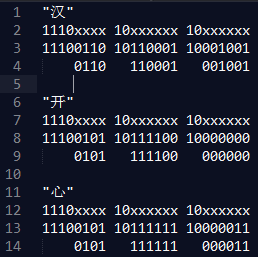[Erlang 0107] Erlang实现文本截断
> string:substr("abcd我们就是喜欢Erlang,就是喜欢OTP",,).
[,,]
> io:format("~ts",[v()]).
d我们ok
Eshell V5.10.2 (abort with ^G)
> u:sub().
[,,]
> io:format("~ts",[v()]).
dæok
> q().
ok
>
%% coding: utf-
Eshell V5.10.2 (abort with ^G)
> u:sub().
[,,]
> io:format("~ts",[v()]).
d我们ok
-define(DEFAULT_ENCODING, latin1). -spec default_encoding() -> source_encoding(). default_encoding() ->
?DEFAULT_ENCODING. -spec encoding_to_string(Encoding) -> string() when
Encoding :: source_encoding(). encoding_to_string(latin1) -> "coding: latin-1";
encoding_to_string(utf8) -> "coding: utf-8".
The Erlang source file encoding is selected by a comment in one of the first two lines of the source file. The first string that matches the regular expression coding\s*[:=]\s*([-a-zA-Z0-9])+ selects the encoding. If the matching string is not a valid encoding it is ignored. The valid encodings are Latin-1 and UTF-8 where the case of the characters can be chosen freely.
As of Erlang/OTP R16 Erlang source files can be written in either UTF-8 or bytewise encoding (a.k.a. latin1 encoding). The details on how to state the encoding of an Erlang source file can be found in epp(3). Strings and comments can be written using Unicode, but functions still have to be named using characters from the ISO-latin-1 character set and atoms are restricted to the same ISO-latin-1 range. These restrictions in the language are of course independent of the encoding of the source file. Erlang/OTP R18 is expected to handle functions named in Unicode as well as Unicode atoms. http://www.erlang.org/doc/apps/stdlib/unicode_usage.html
R16B之前版本
-module(u).
-compile(export_all).
test() ->
t("abcd我们就是喜欢Erlang,就是喜欢OTP",). test2() ->
tw("Youth is not a time of life; it is a state of mind; it is not a matter of
rosy cheeks, red lips and supple knees; it is a matter of the will, a
quality of the imagination, a vigor of the emotions; it is the freshness of
the deep springs of life.",10). dump(FileName,Data)->
file:write_file(FileName, io_lib:fwrite("~s.\n", [Data])). sub()->
string:substr("abcd我们就是喜欢Erlang,就是喜欢OTP",,). t(Input,Max) ->
truncatechars(Input,Max). tw(Input,Max) ->
truncatewords(Input,Max). %% @doc Truncates a string after a certain number of characters.
truncatechars(_Input, Max) when Max =< ->
"";
truncatechars(Input, Max) when is_binary(Input) ->
list_to_binary(truncatechars(binary_to_list(Input), Max));
truncatechars(Input, Max) ->
truncatechars(Input, Max, []). %% @doc Truncates a string after a certain number of words.
truncatewords(_Input, Max) when Max =< ->
"";
truncatewords(Input, Max) when is_binary(Input) ->
list_to_binary(truncatewords(binary_to_list(Input), Max));
truncatewords(Input, Max) ->
truncatewords(Input, Max, []). truncatechars([], _CharsLeft, Acc) ->
lists:reverse(Acc);
truncatechars(_Input, , Acc) ->
lists:reverse("..." ++ Acc);
truncatechars([C|Rest], CharsLeft, Acc) when C >= # ->
truncatechars(Rest, CharsLeft + , [C|Acc]);
truncatechars([C|Rest], CharsLeft, Acc) when C >= # ->
truncatechars(Rest, CharsLeft + , [C|Acc]);
truncatechars([C|Rest], CharsLeft, Acc) when C >= # ->
truncatechars(Rest, CharsLeft + , [C|Acc]);
truncatechars([C|Rest], CharsLeft, Acc) when C >= # ->
truncatechars(Rest, CharsLeft + , [C|Acc]);
truncatechars([C|Rest], CharsLeft, Acc) when C >= # ->
truncatechars(Rest, CharsLeft, [C|Acc]);
truncatechars([C|Rest], CharsLeft, Acc) ->
truncatechars(Rest, CharsLeft - , [C|Acc]). truncatewords(Value, _WordsLeft, _Acc) when is_atom(Value) ->
Value;
truncatewords([], _WordsLeft, Acc) ->
lists:reverse(Acc);
truncatewords(_Input, , Acc) ->
lists:reverse("..." ++ Acc);
truncatewords([C1, C2|Rest], WordsLeft, Acc) when C1 =/= $\ andalso C2 =:= $\ ->
truncatewords([C2|Rest], WordsLeft - , [C1|Acc]);
truncatewords([C1|Rest], WordsLeft, Acc) ->
truncatewords(Rest, WordsLeft, [C1|Acc]).
test() ->
t("abcd我们就是喜欢Erlang,就是喜欢OTP",). dump(FileName,Data)->
file:write_file(FileName, io_lib:fwrite("~s.\n", [Data])). Eshell V5.10.2 (abort with ^G)
> u:test().
[,,,,,,,,,,,,,,,
,,,,,,,,,]
>
> u:dump("u_result",v()).
ok
>
[root@nimbus demo]# cat u_result
abcd我们就是喜欢....
|
Unicode编码(16进制)
|
UTF-8 字节流模板
|
|
000000 - 00007F
|
0xxxxxxx
|
|
000080 - 0007FF
|
110xxxxx 10xxxxxx
|
|
000800 - 00FFFF
|
1110xxxx 10xxxxxx 10xxxxxx
|
|
010000 - 10FFFF
|
11110xxx 10xxxxxx 10xxxxxx 10xxxxxx
|
Eshell V5.10.2 (abort with ^G)
> unicode:characters_to_binary("开心").
<<,,,,,>>
> unicode:characters_to_list("开心").
[,]
> integer_to_list(,).
""
> integer_to_list(,).
""
> integer_to_list(,).
""

[Erlang 0107] Erlang实现文本截断的更多相关文章
- [Erlang 0124] Erlang Unicode 两三事 - 补遗
最近看了Erlang User Conference 2013上patrik分享的BRING UNICODE TO ERLANG!视频,这个分享很好的梳理了Erlang Unicode相关的问题,基本 ...
- [Erlang 0129] Erlang 杂记 VI
把之前阅读资料的时候记下的东西,整理了一下. Adding special-purpose processor support to the Erlang VM P23 简单介绍了Erlang C ...
- [Erlang 0122] Erlang Resources 2014年1月~6月资讯合集
虽然忙,有些事还是要抽时间做; Erlang Resources 小站 2014年1月~6月资讯合集,方便检索. 小站地址: http://site.douban.com/204209/ ...
- [Erlang 0105] Erlang Resources 小站 2013年1月~6月资讯合集
很多事情要做,一件一件来; Erlang Resources 小站 2013年1月~6月资讯合集,方便检索. 小站地址: http://site.douban.com/204209/ ...
- Erlang 103 Erlang分布式编程
Outline 笔记系列 Erlang环境和顺序编程Erlang并发编程Erlang分布式编程YawsErlang/OTP 日期 变更说明 2014-11-23 A Outl ...
- 解决NSTextContainer分页时文本截断问题
解决NSTextContainer分页时文本截断问题 NSTextContainer与NSLayoutManager配合使用可以将大文本文件分页,但是,分页过程中会遇到问题,显示字符被截断的问题:) ...
- [Erlang 0057] Erlang 排错利器: Erlang Crash Dump Viewer
http://www.cnblogs.com/me-sa/archive/2012/04/28/2475556.html Erlang Crash Dump Viewer真的是排错的天兵神器,还记得我 ...
- [Erlang 0119] Erlang OTP 源码阅读指引
上周Erlang讨论群里面提到lists的++实现,争论大多基于猜测,其实打开代码看一下就都明了.贴出代码截图后有同学问这代码是哪里找的? "代码去哪里找?",关于Erla ...
- [Erlang 0123] Erlang EPMD
epmd进程和Erlang节点进程如影随形,在Rabbitmq集群,Ejabberd集群,Couchbase集群产品文档中都会有相当多的内容讲epmd,epmd是什么呢? epmd 是Erlan ...
随机推荐
- (转)J2EE的13种核心技术
一.JDBC(Java Database Connectivity) JDBC API为访问不同的数据库提供了一种统一的途径,象ODBC一样,JDBC对开发者屏蔽了一些细节问题,另外,JDBC对数据 ...
- geotrellis使用(十二)再记录一次惨痛的伪BUG调试经历(数据导入以及读取瓦片)
Geotrellis系列文章链接地址http://www.cnblogs.com/shoufengwei/p/5619419.html 目录 前言 BUG还原 查找BUG 解决方案 总结 后记 一.前 ...
- 关于纠正 C/C++ 之前在函输内改变 变量的一个错误想法。
再这之前,我曾认为,一个变量只要定义为全局变量后,即使把它以传参的方式传进去一个函数内,也能改变它的值 事实证明,这一想法是错的. 下面我用代码说明,具体注释将写在里面 #include<std ...
- js ES6 对字符的操作注意事项
1.codePointAt方法是测试一个字符由两个字节还是由四个字节组成的最简单方法. function is32Bit(c) { return c.codePointAt(0) > 0xFFF ...
- [TSM]在调度计划的时候出现 “ANS1125E Unmatched Quotes: 'string' ”错误的替代解决办法
环境: TSMserver:TSM 6.2.3 for Windows Server 2008 R2 TSMclient: TSM 5.5.0 for CentOS 遇到的故障: ANS1125E U ...
- 整合struts2+hibernate详细配置步骤及注意事项
刚刚学完这两个框架,就迫不及待的做了一个例子,在整合两个框架的时候,也碰到了一些小问题,下面介绍一下配置的步骤: 1.创建一个自定义的struts2和hibernate的类库 因为之前写例子都是直接将 ...
- 重温JSP学习笔记--三大指令九大内置对象
最近在温习javaweb的相关基础知识,鉴于我弄丢了记满了整整一本的笔记,决定以后把笔记和一些学习上的心得以及碰到的一些问题统统都放在网上,今天看了一下jsp的相关基础,以下是笔记: JSP三大指令: ...
- 【JUC】JDK1.8源码分析之ReentrantLock(三)
一.前言 在分析了AbstractQueuedSynchronier源码后,接着分析ReentrantLock源码,其实在AbstractQueuedSynchronizer的分析中,已经提到过Ree ...
- 关于dijkstra算法的一点理解
最近在准备ccf,各种补算法,图的算法基本差不多看了一遍.今天看的是Dijkstra算法,这个算法有点难理解,如果不深入想的话想要搞明白还是不容易的.弄了一个晚自习,先看书大致明白了原理,就根据书上的 ...
- BF算法与KMP算法
BF(Brute Force)算法是普通的模式匹配算法,BF算法的思想就是将目标串S的第一个字符与模式串T的第一个字符进行匹配,若相等,则继续比较S的第二个字符和 T的第二个字符:若不相等,则比较S的 ...

